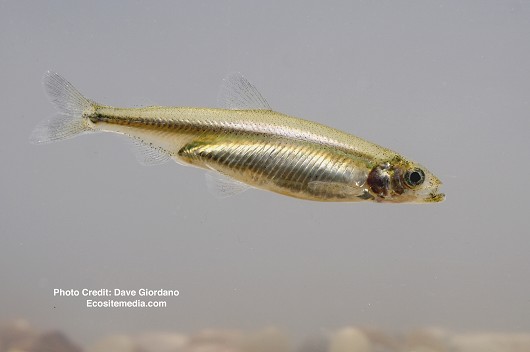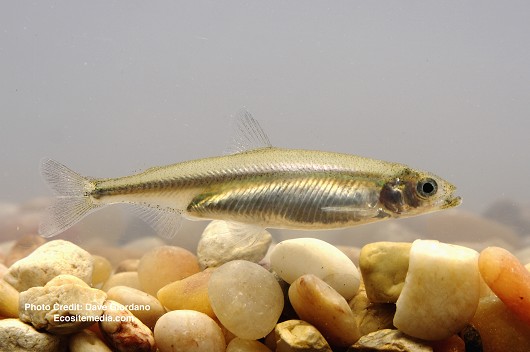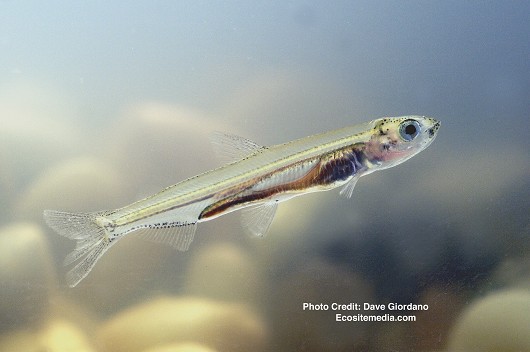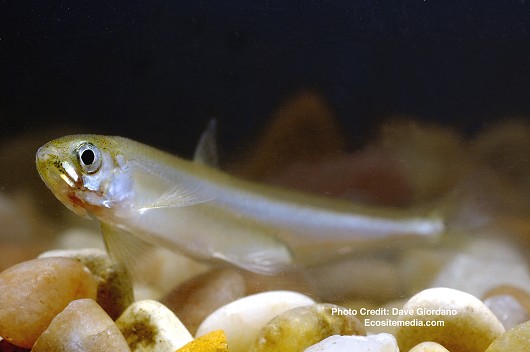Delta Smelt
-
Scientific NameHypomesus pacificus
-
NativeYes
-
Identification
 Delta Smelt, Adult (swimming), UC Davis Fish Conservation and Culture Lab, Byron, CA (largely funded by the California Department of Water Resources) May 15, 2008
Delta Smelt, Adult (swimming), UC Davis Fish Conservation and Culture Lab, Byron, CA (largely funded by the California Department of Water Resources) May 15, 2008 Delta Smelt, Adult (side view), UC Davis Fish Conservation and Culture Lab, Byron, CA (largely funded by the California Department of Water Resources) May 15, 2008
Delta Smelt, Adult (side view), UC Davis Fish Conservation and Culture Lab, Byron, CA (largely funded by the California Department of Water Resources) May 15, 2008 Delta Smelt, juvenile (swimming), UC Davis Fish Conservation and Culture Lab, Byron, CA (largely funded by the California Department of Water Resources) May 15, 2008. Note: lower half of caudal fin is torn.
Delta Smelt, juvenile (swimming), UC Davis Fish Conservation and Culture Lab, Byron, CA (largely funded by the California Department of Water Resources) May 15, 2008. Note: lower half of caudal fin is torn. Delta Smelt, Adult (frontal left view), UC Davis Fish Conservation and Culture Lab, Byron, CA (largely funded by the California Department of Water Resources) May 15, 2008.
Delta Smelt, Adult (frontal left view), UC Davis Fish Conservation and Culture Lab, Byron, CA (largely funded by the California Department of Water Resources) May 15, 2008.- Small and slim, up to 120 mm SL
- Adipose fin present
- Large eyes, small mouth: maxilla doesn’t extend past middle of eye, small pointed teeth
- Pectoral fins reach < 2/3 distance to pelvic fins
- Coloration: almost translucent, sides have blue sheen
- Dark spot rarely present between jaws
- Fin rays: dorsal 8-11, pelvic 8, pectoral 10-12, anal 15-19
- Lateral line scales (incomplete): 53-60
-
Life History
Delta Smelt are euryhaline and primarily live in or just upstream of the mixing zone between fresh and salt water in the San Francisco Bay-Delta. Typically these upper estuarine areas are shallow and have salinities ranging from 2-7 ppt. Delta Smelt live in water with salinities ranging from 0 to 18.4 ppt and can tolerate salinities up to 19.0 ppt. Suisun Bay, CA is usually the location of this mixing zone, though changes in streamflow can affect how far downstream these low salinity waters occur. Delta Smelt can live in water temperatures ranging form 6 to 28°C with lethal levels at 29°C, though their success seems to have little relation to water temperatures. Smelt are short burst swimmers that feed on plankton and therefore they are typically found in places with low water velocities where the water is cool and well oxygenated. They share habitat preferences but they are not shoaling fish. Planktonic food items include copepods, cladocerans, amphipods, and insect larva. Young smelt tend to focus on immature stages of calanoid copepods while adult smelt may feed on all life stages as well as other large planktonic organisms. Delta Smelt grow quickly and the growth rate is largely food dependent. The most rapid growth occurs when they reach 30 mm FL and are large enough to prey on a wider variety of food sources. In 7-9 months they reach lengths of 55-70 mm SL with growth slowing in the several months that follow. A few smelt live a second year and reach lengths of 90-120 mm SL. In spring smelt populations are dominated by spawning adults, and by summer they have died and given rise to the next generation of juveniles. Spawning occurs in upstream spawning grounds from February to July, though fish begin moving up the delta as early as September or October. Delta Smelt spawn mostly at night during low tide in freshwater sloughs and shallow edge waters. In the Sacramento River fish typically spawn above Rio Vista. Smelt have also been recorded spawning in different parts of Suisun Bay and the Napa River Estuary. Females move to the bottom of the water column where they are accompanied by a male. The two swim side by side and release eggs and milt, the male fish sometimes pausing to ward off other attending males. Females lay 1,200 to 2,600 eggs depending on body size and most eggs come from the left ovary. The eggs hatch in 9-13 days at a water temperature of 14.8-16.5°C. The emergent larvae begin feeding on rotifers and minuscule prey in 4-5 days. The larvae have an oil sac that keeps them semi-buoyant till their swimbladders develop several weeks later. At that point they are capable of rising into the water column where they are washed downstream by the current into the mixing zone. The number of spawning fish is weakly or nominally associated with the number of the next generation.
-
Links to Other ResearchN / A



